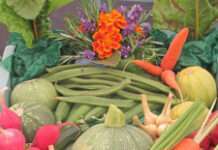Washing hands remains among most important food safety steps
MANHATTAN, Kan. – While it may seem as though some health precautions have changed during the course of the COVID-19 pandemic, one truth has remained intact.
Food and food packaging is safe from the virus.
“Throughout this pandemic, neither food nor any food packaging has been linked to any COVID-19 illness,” said Karen Blakeslee, a food scientist with Kansas State University.
Blakeslee cited a Feb. 18 report from the U.S. Department of Agriculture indicating that of the more than 100 million cases of COVID-19 in the U.S., “we have not seen any epidemiological evidence of food or food packaging as the sources of SARS-CoV-2 transmission to humans.”
“Food business operations,” the report notes, “continue to produce a steady supply of safe food following current Good Manufacturing Practices and preventive controls, focusing on good hygiene practices and keeping workers safe.”
The report highlights an important fact that consumers play an important role in maintaining the safety of food, especially foods being delivered to others. Even if the risk of transferring COVID-19 on food packaging is low, those who deliver or prepare food must continue to adhere to accepted food safety practices.
Among the most important is also one that is well known: Washing your hands.
“Hand washing prevents the spread of bacteria from any items you touch,” Blakeslee said. “According to the U.S. Centers for Disease Control, hand washing can reduce illness from diarrhea by 23-40%. There are many foodborne illnesses that result in diarrhea. So hand washing can reduce that risk dramatically.”
Blakeslee’s feeling is that consumers and food preparers have taken safe food handling seriously, something she says “is encouraging.”
“Incorporating food safety practices such as clean, cook, chill and separate are a part of behavior change,” she said. “It is not just the responsibility of food producers, food manufacturers, grocery stores, restaurants and other food services. The bottom line is each of us has the responsibility to handle food safely.”
Blakeslee, who is also coordinator of K-State’s Rapid Response Center for food science, publishes a monthly newsletter, called You Asked It!, that addresses many issues related to food science and safety.
More information on food safety also is available online from K-State Research and Extension.
FOR PRINT PUBLICATIONS: Links used in this article
COVID-19 Update: USDA report, www.usda.gov/media/press-releases/2021/02/18/covid-19-update-usda-fda-underscore-current-epidemiologic-and
Why Wash Your Hands (U.S. Centers for Disease Control), www.cdc.gov/handwashing/why-handwashing.html
Four Steps to Food Safety, www.foodsafety.gov/keep-food-safe/4-steps-to-food-safety
Rapid Response Center for food science, www.rrc.ksu.edu
You Asked It! (newsletter), www.rrc.k-state.edu/newsletter/index.html
K-State Research and Extension food safety, www.ksre.k-state.edu/foodsafety
K State Research and Extension is a short name for the Kansas State University Agricultural Experiment Station and Cooperative Extension Service, a program designed to generate and distribute useful knowledge for the well being of Kansans. Supported by county, state, federal and private funds, the program has county extension offices, experiment fields, area extension offices and regional research centers statewide. Its headquarters is on the K State campus in Manhattan. For more information, visit www.ksre.ksu.edu. K-State Research and Extension is an equal opportunity provider and employer.
Story by:
Pat Melgares
785-532-1160
[email protected]
For more information:
Karen Blakeslee
785-532-1673
[email protected]





